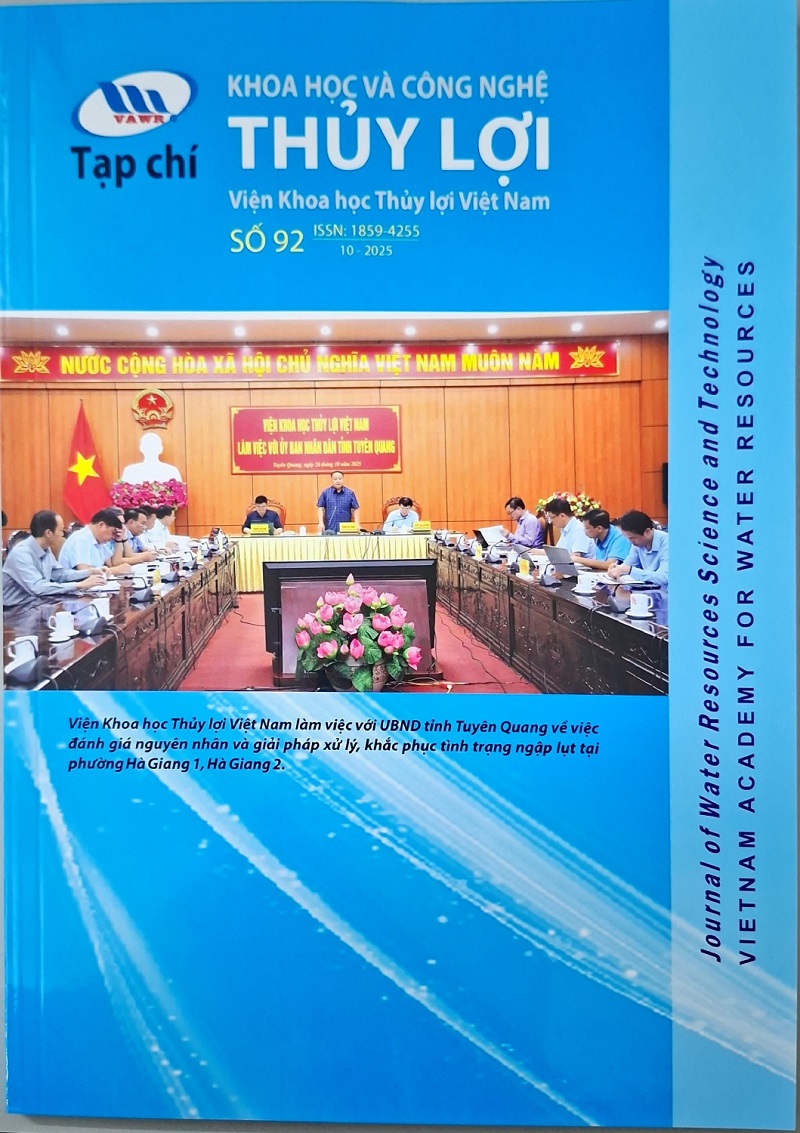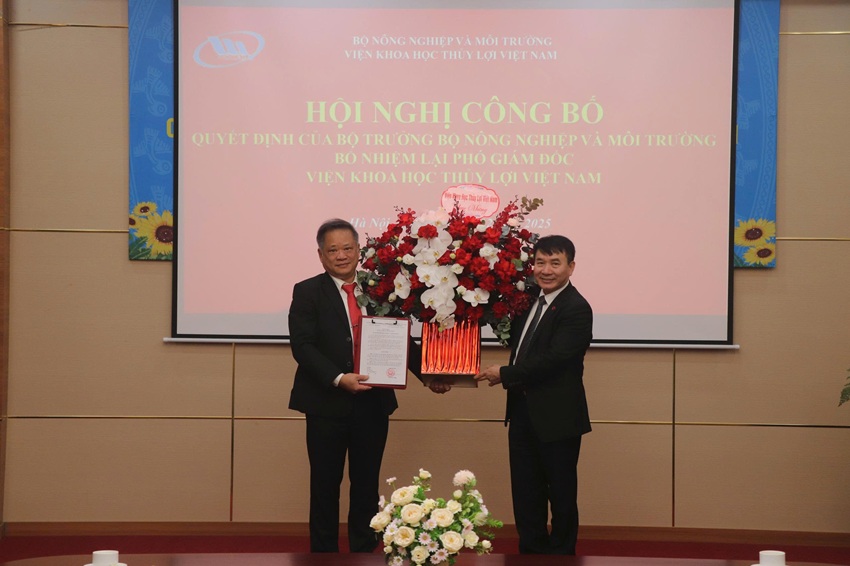Hydrodynamic Condition Modeling along the North-Central Coast of Vietnam
26/08/2021An extremely dynamic morphology of the estuary is observed in the coastal regions of Vietnam under the governing processes of tides, waves, and river system flows. The primary target of this paper is to provide insight into the governing processes and morphological behavior of the Nhat Le estuary, located in the north-central coast of Vietnam. Based on measured data from field surveys and satellite images combined with numerical model simulations of MIKE and Delft3D, the influences of seasonal river flow, tides, and wave dynamics on the sediment transport and morphological changes are fully examined. The study showed that freshwater flow in the flood season plays a central role in cutting off the southern sandspit, maintain and shaping the main channel. The prevailing waves in winter and summer induce longshore drift and sediment transport in the southeast to northwest direction. In the low flow season, this longshore sediment transport is dominant, causing sediment to deposit on the southern side of the ebb tidal delta and elongating the southern sandspit which narrows the estuary entrance and reorients the main channel.
I. INTRODUCTION
II. THE STUDY AREA
III. MATERIALS AND METHODOLOGY
A. Materials
B. Numerical Modeling: Set-up and Boundary Conditions
IV. RESULTS AND DISCUSSION
A. Results
B. Discussion
1) Wave Characteristics
2) Estuary Hydrodynamics
3) Sediment Transport and Bottom Changes
V. CONCLUSIONS
REFERENCES
[1] G. Masselink, “The effect of sea breeze on beach morphology, surf zone hydrodynamics and sediment resuspension”, Marine Geology, Vol. 146, No. 1-4, pp. 115-135, 1998
[2] M. Luo, N. C. Lau, “Synoptic characteristics, atmospheric controls, and long-term changes of heat waves over the Indochina Peninsula”, Climate Dynamics, Vol. 51, No. 7-8, pp. 2707-2723, 2018
[3] N. T. Thanh, N. H. Son, “Understanding shoreline and riverbank changes under the effect of meteorological forcings”, 10th International Conference on Asian and Pacific Coasts, Hanoi, Vietnam, September 26-28, 2019
[4] A. N. Laghari, W. Rauch, M. A. Soomro, “A hydrological response analysis considering climatic variability”, Engineering, Technology & Applied Science Research, Vol. 8, No. 3, pp. 2981-2984, 2018
[5] A. Liaghat, A. Adib, H. R. Gafouri, “Evaluating the effects of dam construction on the morphological changes of downstream meandering rivers (case study: Karkheh river)”, Engineering, Technology & Applied Science Research, Vol. 7, No. 2, pp. 1515-1522, 2017
[6] M. Rinaldi, B. Mengoni, L. Luppi, S. E. Darby, E. Mosselman, “Numerical simulation of hydrodynamics and bank erosion in a river bend”, Water Resources Research, Vol. 44, No. 9, Article ID W09428, 2008
[7] Deltares, Delft3D-FLOW: Simulation of multi-dimensional hydrodynamic flows and transport phenomena, including sediments. User manual, version 3.15, Deltares, 2011
[8] L. C. Van Rijn, Principles of sediment transport in rivers, estuaries and coastal seas, Aqua, 1993
[9] L. C. Van Rijn, “Unified view of sediment transport by currents and waves. I: Initiation of motion, bed roughness, and bed-load transport”, Journal of Hydraulic Engineering, Vol. 133, No. 6, pp. 649-667, 2007
[10] L. C. Van Rijn, “Unified view of sediment transport by currents and waves. II: Suspended transport”, Journal of Hydraulic Engineering, Vol. 133, No. 6, pp. 668-689, 2007
[11] L. C. Van. Rijn, “Unified view of sediment transport by currents and waves. III: Graded beds”, Journal of Hydraulic Engineering, Vol. 133, No. 7, pp. 761-775, 2007
[12] L. C. Van Rijn, D. J. R. Walstra, M. V. Ormondt, “Unified view of sediment transport by currents and waves. IV: Application of morphodynamic model”, Journal of Hydraulic Engineering, Vol. 133, No. 7, pp. 776-793, 2007
[13] DHI, Users manual: MIKE 11, Danish Hydraulic Institute, 2005
[14] D. N. Graham, M. B. Butts, “Flexible, integrated watershed modeling with MIKE SHE”, in: Watershed Models, CRC Press, 2005
[15] A. H. Kamel, “Application of a hydrodynamic MIKE 11 model for the Euphrates river in Iraq”, Slovak Journal of Civil Engineering, Vol. 2, No. 1, pp. 1-7, 2008
[16] J. R. Thompson, H. R. Sorenson, H. Gavin, A. Refsgaard, “Application of the coupled MIKE SHE/MIKE 11 modelling system to a lowland wet grassland in southeast England”, Journal of Hydrology, Vol. 293, No. 1-4, pp. 151-179, 2004
[17] I. R. Warren, H. K. Bach, “MIKE 21: A modelling system for estuaries, coastal waters and seas”, Environmental Software, Vol. 7, No. 4, pp. 229-240, 1992
[18] W. S. Merritt, R. A. Letcher, A. J. Jakeman, “A review of erosion and sediment transport models”, Environmental Modelling & Software, Vol. 18, No. 8-9, pp. 761-799, 2003
[19] N. D. Thao, H. Takagi, M. Esteban, Coastal disasters and climate change in Vietnam: Engineering and planning perspectives, Elsevier, 2014
[20] Y. Mazda, M. Magi, H. Nanao, M. Kogo, T. Miyagi, N. Kanazawa, D. Kobashi, “Coastal erosion due to long-term human impact on mangrove forests”, Wetlands Ecology and Management, Vol. 10, No. 1, pp. 1-9, 2002
[21] Trimble, Trimble R8s GNSS Receiver: User guide, Trimble, 2015
[22] B. Bayram, I. Janpaule, M. Ogurlu, S. Bozkurt, H. C. Reis, D. Z. Seker, “Shoreline extraction and change detection using 1: 5000 scale orthophoto maps: A case study of Latvia-Riga“, International Journal of Environment and Geoinformatics, Vol. 2, No. 3, pp. 1-6, 2015
[23] A. A. Alesheikh, A. Ghorbanali, N. Nouri, “Coastline change detection using remote sensing”, International Journal of Environmental Science & Technology, Vol. 4, No. 1, pp. 61-66, 2007
[24] DHI, MIKE 1D: DHI Simulation Engine for 1D river and urban modelling. Reference manual, DHI U Danish Hydraulic Institute, 2012
[25] DHI, MIKE 11: A modelling system for rivers and channels, Danish Hydraulic Institute, 2012
[26] J. E. Nash, J. V. Sutcliffe, “River flow forecasting through conceptual models, Part I: A discussion of principles”, Journal of Hydrology, Vol. 10, No. 3, pp. 282–290, 1970
[27] Delft, SWAN user manual, SWAN Cycle III version 41.20A, Delft University of Technology, 2011
[28] Deltares, Delft3D-WAVE: Simulation of short-crested waves with SWAN, User manual, version 3.04, Delft University of Technology, 2011
[29] L. H. Holthuijsen, N. Booij, T. H. C. Herbers, “A prediction model for stationary, short-crested waves in shallow water with ambient currents”, Coastal Engineering, Vol. 13, No. 1, pp. 23-54, 1989
[30] G. D. Egbert, A. F. Bennett, M. G. G. Foreman, “TOPEX/POSEIDON tides estimated using a global inverse model”, Journal Geophysical Research, Vol. 9, No. C12, pp. 24821–24852, 1994
[31] H. L. Tolman, “Validation of WAVEWATCH III version 1.15 for a global domain”, NOAA/NWS/NCEP/OMB Technical Note 213, 2002
[32] L. C. Van Rijn, “Sediment transport, part I: Bed load transport”, Journal of Hydraulic Engineering, Vol. 110, No. 10, pp. 1431-1456, 1984
[33] L. C. Van Rijn, Handbook sediment transport by currents and waves, Delft Hydraulics, 1989
See detail: Hydrodynamic Condition Modeling along the North-Central Coast of Vietnam
Dao Dinh Cham | Nguyen Thai Son | Nguyen Quang Minh |
Nguyen Thanh Hung | Nguyen Tien Thanh |
Engineering, Technology & Applied Science Research Vol. 10, No. 3, 2020, 5648-5654
Ý kiến góp ý:









